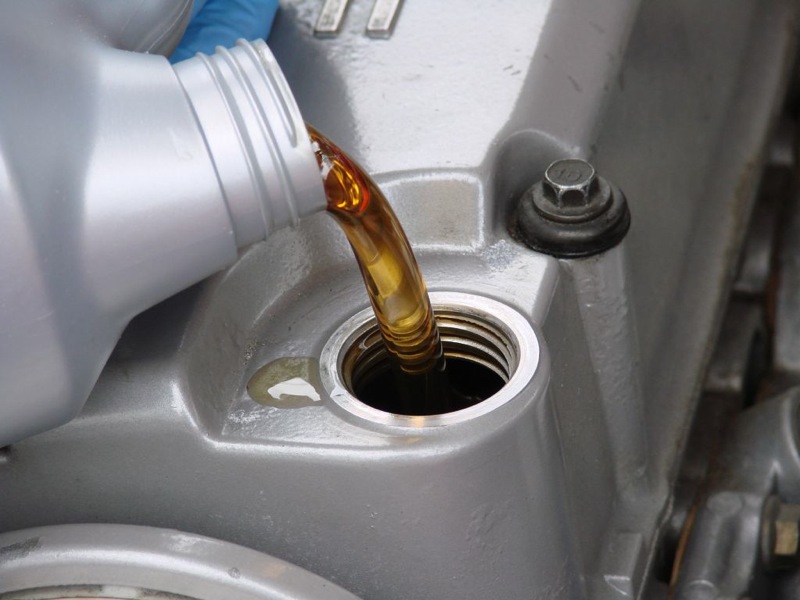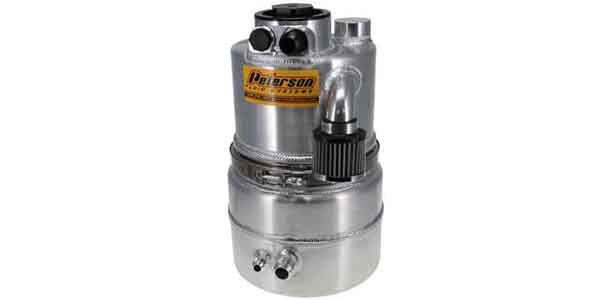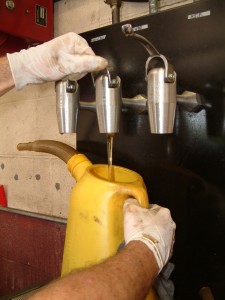 Every engine builder knows the importance of using not only high-quality motor oil in an engine, but also an oil that has the right additive package and viscosity for the application. This is especially important in performance applications where extremes of heat and pressure can push many ordinary motor oils to the brink.
Every engine builder knows the importance of using not only high-quality motor oil in an engine, but also an oil that has the right additive package and viscosity for the application. This is especially important in performance applications where extremes of heat and pressure can push many ordinary motor oils to the brink.
Motor oil can make or break an engine. It lubricates the main and rod bearings, cylinders, pistons and rings, the camshaft and valve train. It helps cool the bearings, pistons and valve springs, and in turbochargers it keeps the shaft bearings alive. Oil also helps disperse and neutralize combustion byproducts and moisture that end up in the crankcase, and it helps keep the engine clean.
The additives that are used in motor oils can vary quite a bit as can the base stocks that are used to formulate any given motor oil. Additives make up about 20 to 25% of a quart of oil. Additives help boost the performance level of the base stock oil, and include Viscosity Index Improvers that allow multi-viscosity oil to flow more easily at cold temperatures while retaining film strength and viscosity at high temperatures.
The blend of base stocks and additives is what distinguishes one motor oil from another. So don’t think all motor oils are more or less the same. Even motor oils that have the same viscosity rating and service ratings may perform quite differently depending on the situation.
Types of Oil
When it comes to choosing a motor oil for a given engine application, you have a lot of options from which to choose. There are conventional motor oils made from refined petroleum, various types of “synthetic” oils, “synthetic-blends” and “semi-synthetics.” Synthetic oils are typically made up of extremely refined or “hydro-isomerized” oils, called Group III oils by the API (American Petroleum Institute). For extremely demanding applications blends of “PAO” (Polyalphaolefin) and “POE” (polyol ester) base oils are used, which are API Groups IV and V, respectively. Synthetics provide the best lubrication at both ends of the temperature spectrum, flowing more easily at cold temperatures while resisting viscosity breakdown, oil consumption, oxidation and sludging at high temperatures.
Synthetic-blends and semi-synthetics are a more affordable alternative to a full synthetic, and typically contain less than 30% synthetic oil by volume. Blends help bolster the performance properties of conventional oil, and are a step up from an ordinary Group II base oil. In fact, most of today’s “conventional” 5W-20 and 5W-30 multi-viscosity oils are actually blends and contain a certain amount of Group III oil.
As for the various additives in oil, many are necessary to achieve the minimum API requirements for multi-viscosity rating, wear resistance, cleanliness and so on. API rates motor oils differently if they are for gasoline engines or diesel engines.
Up to Standard
There is also a “donut” that shows the service rating, viscosity and fuel saving properties of the oil. The current API standard for gasoline engines since 2011 has been “SN,” which supersedes the previous “SM” rating (2010), “SL” rating (2004) and “SJ” rating (2001).
All previous gasoline service ratings are now obsolete. Motor oils meeting the most current gasoline engine specifications will also have a “Starburst” on the front label.
Many engine manufacturers print the Starburst in their service manuals to direct customers to the highest performing engine oils available.
The current API service rating for diesel engines is “CJ-4” (introduced in 2010) which supersedes the previous “CI-4” rating (2002) and “CH-4” (1998) ratings. CJ-4 oils are primarily for modern diesel engines designed to meet EPA 2010 (on-road) and Tier IV (off-road) emissions regulations.
These engines burn ultra-low sulfur fuels (less than 15 PPM), have EGR systems, diesel particulate filters and many use DEF and exhaust catalysts – the previous CI-4 oils are for diesels with EGR systems.
Some oils are formulated to minimize friction for better fuel economy (“energy conserving” oils). Some are formulated for longer oil drain intervals (“extended life” oils). Some are formulated to meet the special needs of older high mileage engines (“high mileage” oils that contain an extra dose of seal conditioners, dispersants and detergents).
Others are formulated to provide the kind of protection demanded by high-performance engines (“street performance” oils with extra anti-wear additives and “racing oils”).
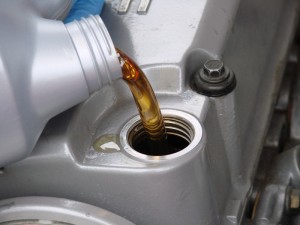
Other Engine Oils
There are also specialty oils for marine engines, small air-cooled engines, diesel engines, and special fuel applications such as ethanol, propane and natural gas. Don’t forget the all-important break-in oils that are formulated with no detergent to help piston rings seat quickly and with extra ZDDP (zinc dialkyl dithiophosphate) anti-wear additive to prevent the cam and lifters from scuffing.
Choosing the “right” motor oil, therefore, is just as important to the longevity of the engines you build as choosing the brand and quality of all the other parts that go into your engines.
Which to Choose?
If you assemble an engine and do the initial break-in and tuning, your control kind of oil goes in the crankcase both during the break-in and dyno sessions.
If you are using a break-in oil (which you should be!), drain it after the initial break-in. Don’t leave it in for the dyno tuning. Break-in oil is for break-in only, not for tuning or driving.
If you are just machining parts for a customer or leaving the final engine assembly and break-in to your customer, your customer (or his sponsor) usually decides what brand, viscosity and type of oil to use – and that may lead to problems if they choose the wrong oil. In situations like these, you should recommend a specific type of lubricant both for break-in and another for everyday driving or racing. There’s no guarantee your customer will follow your advice – unless you warranty the engine and require a certain type of oil to keep the warranty in effect.
This is essentially what GM has done with their “dexos1” oil specification for 2011 and newer Chevy LS engines. Oils that meet the dexos1 performance specifications are a high-quality full synthetic that exceeds current API SN requirements.
It supersedes earlier GM specifications (such as GM6094M, GM4718M and GM-LL-A-025), and is recommended for 2010 and older GM engines as well as new ones. By requiring dexos1, GM is encouraging customers to use high-quality oil that will provide the best possible protection in their engines. GM is also requiring oil companies to license any product that claims to meet dexos1 requirements. There are some full synthetic oils on the market that do meet the dexos1 requirements, but are not labeled as such.
The dexos1 specifications require additional friction modifiers to improve fuel economy, additives to control aeration (which is necessary for variable valve-timing), additives to improve oxidation, varnish, corrosion and deposit control to keep the engine clean (which also helps minimize emissions over the life of the engine), and viscosity improvers and/or base oils that resist viscosity breakdown for extended service intervals. In sort, oils that meet the dexos1 spec far exceed the requirements of most current industry oil standards.
Many auto makers use synthetics as the factory-fill oil in their high-performance models, and for applications where an oil reminder service light tells the vehicle owner when to change the oil. Most of these systems do not actually measure the quality of the oil in the crankcase but use a mathematical algorithm to estimate remaining oil life.
The estimation is based on a variety of inputs including hours of engine operation, miles driven, ambient temperatures and so on.
Oil life in many instances is also based on using high-quality synthetic oil, not an ordinary conventional oil. Under ideal driving conditions, the service light might not come on for up to 10,000 miles, 12,000 miles or longer! Because of this, it’s important to use oil that’s capable of going that kind of distance – and a high-quality, long life oil filter.
Many conventional oils can go up to 7,500 miles between oil changes, though 5,000 miles is a safer interval. Pushing conventional oil beyond 7,500 miles is asking for trouble – especially if the engine has a low flow PCV system that may allow moisture and sludge to build up inside the crankcase. Chrysler 3.5L engines are notorious for sludging up for this very reason. A lot of Toyota engines have experienced similar problems.
Euro Engine Oils
Like their domestic counterparts, European auto makers such as Audi, BMW, Mercedes, Porsche and VW all have their own oil requirements. The difference is many of the European requirements are engine specific rather than make or model specific. Consequently, there are a LOT of different specs to take into consideration when choosing a motor oil for a European application.
The latest European standards were updated in 2012 and include three basic sets of ratings for gasoline & light-duty diesel engines, light-duty diesel with exhaust after treatment, and heavy-duty diesels. Within each of these sets are subcategories that cover different engine performance requirements:
• A1/B1, A3/B3, A3/B4 & A5/B5 for various gasoline and light-duty diesel applications.
• C1, C2, C3 & C4 for catalyst-equipped gasoline and diesel engines
• E4, E6, E7 & E9 for heavy-duty diesels.
Each subcategory has specific requirements for viscosity, shear stability, evaporation rates, sulfur and phosphor content, wear resistance, high and low temperature performance, sludge resistance and oxidation resistance according to the application.
Using these basic standards, the European auto makers then come up with their own specs for the various engines they produce. Audi, for example, has a number of oil specifications including 501.01, 502.00, 505.00, 505.01, 504.00 & 507.00.
Volkswagen has similar specifications: VW 502.00, 505.00, 505.01. Each number represents a different oil requirement. Finding all of these requirements can be a challenge, as can finding a list of “approved” oils that meet the various Euro requirements.
The best place to find this kind of information is on each vehicle manufacturers’ technical service information website.
Asian Model Oil Standards
A group called the International Lubricant Specification Advisory Committee (ILSAC) made up of Asian and U.S. automakers is responsible for oil performance standards for Asian nameplates. Though not exactly the same as our own API standards, the current ILSAC “GF-5” rating corresponds closely to the API “SN” rating.
Motor oils that meet the Asian GF-5 specification have improved deposit protection for pistons and turbochargers, more stringent sludge control, improved fuel economy, enhanced emission control system compatibility, seal compatibility, and protection for engines using ethanol fuels such as E85.
The current GF-5 standard has been in effect since 2010, and is backwards compatible for previous GF-4 and earlier ratings.
On the Shelf
Most branded oil products that are found on auto parts store shelves and other retail outlets carry both the API and ILSAC ratings, plus any other vehicle manufacturer specifications they also meet.
Most packaged motor oils are quality products that should perform satisfactorily for most motorists under normal driving conditions and oil change intervals.
Most of the synthetic oils are suitable for performance applications, but many are NOT racing oils. Worse yet, most of commonly available brands of oil that meet current API SN and ILSAC G-5 requirements are ill-suited for use in pushrod engines that have flat tappet cams. Consequently, if you want a specialty oil, high-performance oil or racing oil, you may have to buy it direct from an aftermarket oil supplier or their local distributor.
Local speed shops often carry these kinds of oils, but you usually won’t find them in your typical discount auto parts retailer.
ZDDP Reductions
In recent years, the critical anti-wear additive ZDDP has been gradually reduced to help extend the life of the catalytic converter (phosphorus can contaminate the catalyst if the engine is using oil).
Back in the 1980s, motor oils typically contained around 1500 PPM (parts per million) of ZDDP. In the 1990s, that was reduced to 1200 PPM, then down to around 800 PPM in 2005.
That level of anti-wear additive is adequate for overhead cam engines and pushrod engines that have roller cams, but it has proved to be inadequate for engines with flat tappet cams, causing accelerated cam lobe and lifter wear – especially if stiffer valve springs are used.
The demand for longer drain intervals has also caused the amount of detergent to increase, which interferes with the anti-wear protection provided by ZDDP and compounds the problem.
To address this issue, numerous aftermarket suppliers now offer ZDDP crankcase additives that can be mixed with conventional or synthetic oil.
Several companies have also introduced “Hot Rod” or “Street Performance Oils” that contain higher levels of ZDDP to protect the cam and lifters (usually around 2000 PPM). Although some suppliers promote the fact that their racing or performance oil contains more ZDDP than competitive products, more isn’t necessarily better.
According to some oil experts, once you get beyond 2000 PPM of ZDDP, additional ZDDP doesn’t really provide much additional protection and can accelerate acidification and sludging.
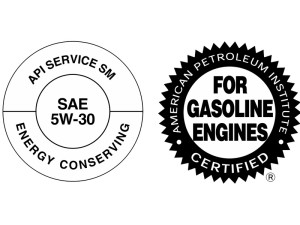 Choosing a Viscosity
Choosing a Viscosity
All multi-viscosity motor oils have a two-digit designation. The first number in a multi-viscosity rating refers to the oil’s cold flow characteristics while the second number refers to its hot flow characteristics.
Thus, a 5W-20 oil acts like a straight 5W oil for easier cold weather cranking and lubrication of critical upper valve train components, and maintains its viscosity when hot, like a SAE 30 oil for good oil film strength and oil pressure.
Most late model engines are factory filled with multi-viscosity 5W-20 or 5W-30 motor oil, and some (mostly imports) require 5W-40, 0W-20 or 0W-30. It’s important to follow the viscosity recommendations because many of these engines have tighter bearing clearances that require low-viscosity oil for proper lubrication. Thin oils also work best with Variable Valve Timing (VVT) systems, and flow more quickly to overhead cams following a cold start.
Thinner oils improve fuel economy. But if the oil is too thin, it may not provide enough film strength at high temperature to protect the bearings in an engine with increased bearing clearances. On the other hand, thicker oil is good for maintaining good oil pressure in a performance engine. But if the oil is too heavy it may interfere with the normal operation of the variable valve timing system, or be slow to circulate when a cold engine is first started. Churning excessively thick oil can also generate heat and rob the engine of power.
Addressing GDI Needs
Another factor to consider when choosing motor oil is how it may contribute to intake valve deposits. This has become a major issue on many late model Gasoline Direct Injection (GDI) engines.
Deposits can form on the intake valves in these engines because fuel is sprayed directly into the combustion chamber rather than the intake port.
There’s no fuel spray to keep the valves clean so the detergents in the fuel do almost nothing in these applications.
Oil drawn into the intake manifold through the PCV system combined with any oil that gets past the valve guides can oxidize and form deposits on the valves. Over time, this can interfere with airflow and cause performance problems and even misfires.
A motor oil with a low volatility rating (its “NOACK” number, which is based on the ASTM D5800 lab test) is best for GDI engines because it will reduce oil consumption and help keep the PCV system and intake valves clean. Most recent European oil specifications call for a low NOACK rating (less than 15%).
Re-Refined Oils
Another change in motor oils is the introduction of more “green” products that contain up to 50% or more “re-refined” motor oil. The U.S. generates about 1.8 billion gallons of waste oil a year.
About 60 to 70% of the used oil that is recovered is burned as a heat source for various industrial processes, but nearly 30 percent is recycled and made into usable base stocks for lubricants and other petrochemical products. Used motor oil can be re-refined eight to 10 times, extending the useful life of a valuable waste product.
Recycled motor oil is re-refined using a multi-step refining procedure that is very similar to that which is used to refine crude oil. The resulting base stock is as good or better than comparable virgin oil, and meets the same API and OEM performance requirements when it is reformulated with the proper additives.
Re-refined motor oil is being used successfully by numerous fleets, the U.S. military and ordinary motorists.
Oils For the Job
The oil you ultimately decide to use (or recommend) for a particular engine will therefore depend on the engine, bearing clearances, the type of fuel it burns and how the engine will be used.
For an everyday driver, most off-the-shelf oils (conventional or synthetic) should work just fine.
Choose a viscosity that’s appropriate for the bearing clearances and ambient temperature range (5W-20, 5W-30 or 10W-30 for year round driving).
Heavier oils (15W-40, 15W-50, 20W-50, etc.) should only be used for warm weather (65°F or higher).
If you are building a performance small block or big block with a flat tappet cam, make sure the oil you choose contains extra ZDDP, or use a ZDDP additive.
If the application is an all-out racing engine, choose high-quality full synthetic racing oil. Racing oils contain extra ZDDP as well as additional friction modifiers, and can handle temperatures up to 250 to 300°F (or higher).
They also contain fewer detergents, which means they are fine for racing but should NOT be used for everyday driving because they get dirty fast. If the engine burns alcohol, make sure the additive package is for alcohol. For nitrous engines, use a 15W-50 with an additive package that can handle the extra fuel dilution.
For any kind of endurance application (off-road), choose racing oil that can handle crankcase contaminants as well as elevated temperatures and loads. Popular viscosities include 20W-50 and 15W-50.
For turbo diesel engines, a high quality 5W-40 with adequate ZDDP is usually the best choice.

